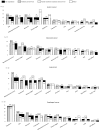Cancer information needs according to cancer type: A content analysis of data from Japan's largest cancer information website
- PMID: 30377575
- PMCID: PMC6205331
- DOI: 10.1016/j.pmedr.2018.10.014
Cancer information needs according to cancer type: A content analysis of data from Japan's largest cancer information website
Abstract
The provision of information about cancer is an important aspect of cancer care. Cancer information provided online is expected to meet the needs of information seekers. Whether information needs vary according to tumor site is largely unknown. We aimed to examine similarities and differences in informational needs by cancer type. Data were collected using a questionnaire administered on Japan's largest cancer information website, "Ganjoho service". A total of 2782 free descriptive responses in the period from April 2012 to December 2017 were analyzed using text-mining software. We identified the top 10 informational need contents, in order of appearance frequency, for eight tumor sites: gastric, colorectal, esophageal, lung, pancreatic, breast, cervical, and prostate cancer. Frequent information needs common to all tumor sites included symptoms, disease stages, treatments, chance of cure, recovery, metastasis, and recurrence. A need for information about diet, pain, side effects of treatments, complementary and alternative medicine was frequent for some tumor sites. Tumor site-specific information should include the following, according to cancer type: information of scirrhous carcinoma for gastric cancer; unusual feces for colorectal cancer; lung X-ray images for lung cancer; early detection for pancreatic cancer; adenocarcinoma, sexual activity, pregnancy, and childbirth for cervical cancer; breast conservation or reconstruction and triple negative cancer for breast cancer; test values and diagnosis and urinary problems for prostate cancer; and hormone therapy for breast and prostate cancer. Cancer information provided online should meet these frequent informational needs, considering similarities and differences of the information required according to tumor site.
Keywords: Cancer; Cancer patients; Cancer survivors; Consumer health information; Health communication; Information dissemination; Information seeking behavior; Information services; Neoplasms.
Figures


Similar articles
-
Demographic and cancer-related differences between self-seeking patients and supported patients: Analysis of cancer information-service data.Psychooncology. 2019 Apr;28(4):759-766. doi: 10.1002/pon.5016. Epub 2019 Feb 12. Psychooncology. 2019. PMID: 30707476
-
Italian cancer figures--Report 2015: The burden of rare cancers in Italy.Epidemiol Prev. 2016 Jan-Feb;40(1 Suppl 2):1-120. doi: 10.19191/EP16.1S2.P001.035. Epidemiol Prev. 2016. PMID: 26951748
-
Unmet informational and supportive care needs of patients following cystectomy for bladder cancer based on age, sex, and treatment choices.Urol Oncol. 2016 Dec;34(12):531.e7-531.e14. doi: 10.1016/j.urolonc.2016.06.010. Epub 2016 Jul 19. Urol Oncol. 2016. PMID: 27449687
-
Overview of resistance to systemic therapy in patients with breast cancer.Adv Exp Med Biol. 2007;608:1-22. doi: 10.1007/978-0-387-74039-3_1. Adv Exp Med Biol. 2007. PMID: 17993229 Review.
-
Informational and emotional needs of long-term survivors of breast cancer.J Adv Nurs. 2005 Sep;51(5):520-8. doi: 10.1111/j.1365-2648.2005.03524.x. J Adv Nurs. 2005. PMID: 16098169 Review.
Cited by
-
Quality of Online Information Regarding Cervical Cancer.Cureus. 2020 Aug 1;12(8):e9511. doi: 10.7759/cureus.9511. Cureus. 2020. PMID: 32879831 Free PMC article.
-
The Therapeutic Efficacy of Dendrimer and Micelle Formulations for Breast Cancer Treatment.Pharmaceutics. 2020 Dec 15;12(12):1212. doi: 10.3390/pharmaceutics12121212. Pharmaceutics. 2020. PMID: 33333778 Free PMC article. Review.
-
Cancer burden and trends in China: A review and comparison with Japan and South Korea.Chin J Cancer Res. 2020 Apr;32(2):129-139. doi: 10.21147/j.issn.1000-9604.2020.02.01. Chin J Cancer Res. 2020. PMID: 32410791 Free PMC article.
-
Communication in Cancer Care in Asia: A Narrative Review.JCO Glob Oncol. 2023 Jun;9:e2200266. doi: 10.1200/GO.22.00266. JCO Glob Oncol. 2023. PMID: 37364221 Free PMC article. Review. No abstract available.
-
The detection of lung cancer using massive artificial neural network based on soft tissue technique.BMC Med Inform Decis Mak. 2020 Oct 31;20(1):282. doi: 10.1186/s12911-020-01220-z. BMC Med Inform Decis Mak. 2020. PMID: 33129343 Free PMC article.
References
-
- Andreassen S., Randers I., Näslund E., Stockeld D., Mattiasson A.C. Family members' experiences, information needs and information seeking in relation to living with a patient with oesophageal cancer. Eur. J. Cancer Care. 2005;14(5):426–434. - PubMed
-
- Andreassen S., Randers I., Näslund E., Stockeld D., Mattiasson A.C. Information needs following a diagnosis of oesophageal cancer; self-perceived information needs of patients and family members compared with the perceptions of healthcare professionals: a pilot study. Eur. J. Cancer Care. 2007;16(3):277–285. - PubMed
-
- Arora N.K. Interacting with cancer patients: the significance of physicians' communication behavior. Soc. Sci. Med. 2003;57(5):791–806. - PubMed
-
- Berretta M., Lleshi A., Fisichella R. The role of nutrition in the development of esophageal cancer: what do we know. Front. Biosci. 2012;4:351–357. - PubMed
LinkOut - more resources
Full Text Sources
Miscellaneous

